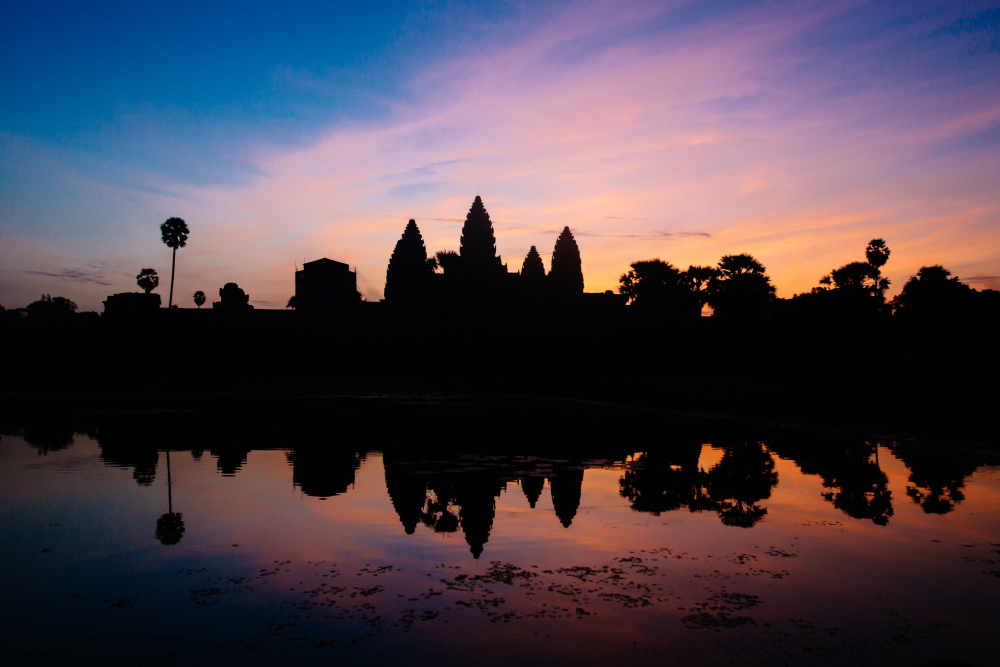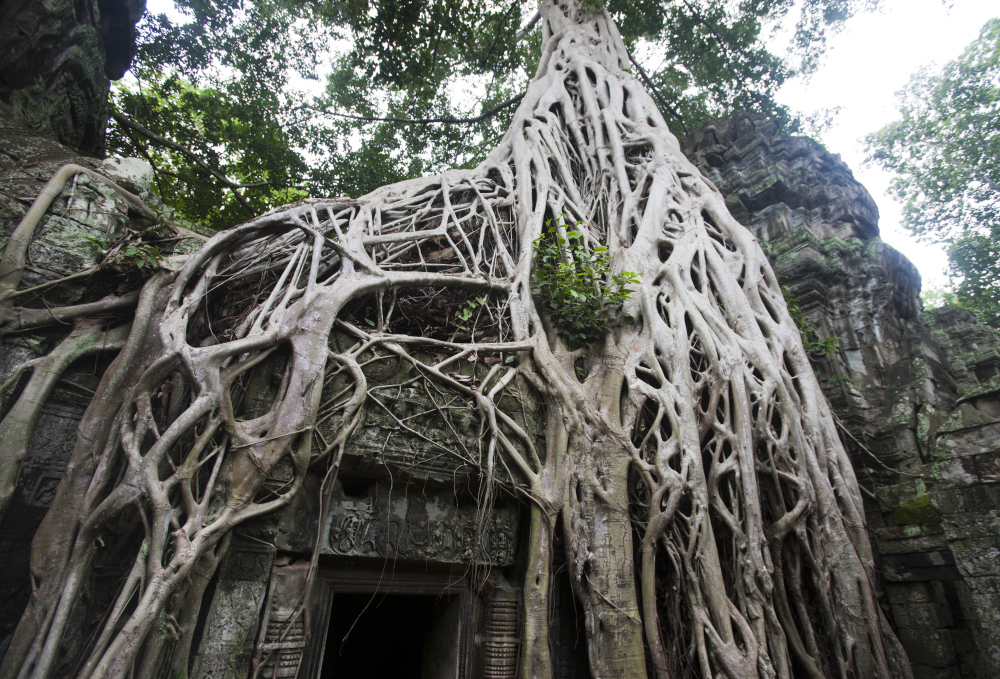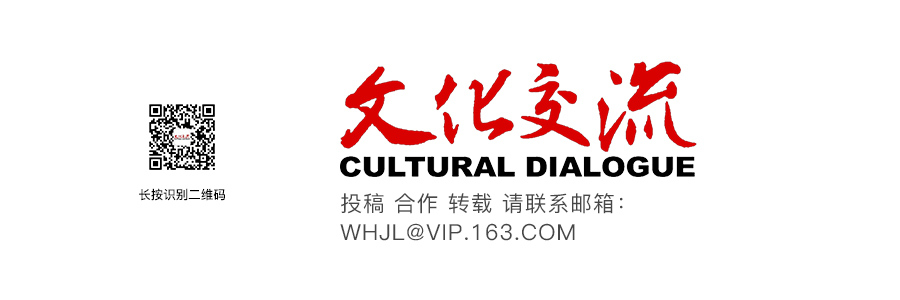为了寻访周达观的足迹,讲述中国“海上丝绸之路”的故事,近日,柬中文化友好协会中国区常务副会长、柬中文化网副总编李毅等,应温州市委宣传部之邀,专程来到温州市,寻访周达观足迹,聆听温州人讲述周达观的故事。
为《元史》补缺
周达观(约1266-1346),自号草庭逸民,出生在今温州城区,《真腊风土记》一书的作者。据记载,元贞元年二月二十日(1295年3月24日)他“自温州开洋,行丁未针”,途经福建、广东、海南诸港,过七洲洋,经交趾洋,三月十五日(4月18日)到达占城(今越南归仁港一带)国都,又经昆仑洋由真浦入境真腊国,之后自真浦出发,过昆仑洋,入真腊第四港(今越南美狄一带),自港口北行,大舟换小舟,一路行舟,入洞里萨湖,七月时到达湖边码头,上岸即是真腊国都吴哥城。
东汉以来,随着中国影响力往南伸展,开始认识中南半岛区域,如三国吴时朱应、康泰往扶南、林邑(今越南一带)宣国威,著有《扶南异物志》《扶南记》等,此为有关真腊(柬埔寨)的最早记载,却又散失在历史的尘埃中。
10至13世纪,是真腊文明最灿烂的时代,史称“吴哥时代”。后遭受暹罗(今泰国)入侵,终沦为废墟,无人知其存在,《元史·外国传》亦无相关记载。

而《真腊风土记》除了描绘真腊吴哥城的建筑和雕刻艺术外,还详细叙述了都城王室与当地风土人情、周达观南行行程及所取途径等,甚有人文历史价值。
当地民众感激这位温州人。在距吴哥城东北60里处有一座山,山上长满荔枝树,据说是由周达观出使时赠送的种子繁殖而来。他们把这座山称为“中国荔枝山”。现在人们去参观吴哥窟时,当地旅游局还会分发《真腊风土记》等资料,介绍中国使者周达观。

但周达观那次的遣使,各史书均未记载。后来真腊王朝迁都金边,都城吴哥逐渐没落,五百余年过去,吴哥被茂密的热带雨林湮没,为世人所不知,简直成了历史的疑案。1861年法国生物学家亨利·穆奥为了寻找热带动植物,无意中发现了宏伟惊人的古庙遗迹,从此隐没已久的“吴哥文明”重现于世。《真腊风土记》便成为现存同时代人撰写吴哥文化极盛时期的唯一记录,是研究柬埔寨古代史和中柬交往友好关系的珍贵文献,为中外史家所肯定。《四库全书总目提要》称此书“文义颇为赅赡﹐本末详具,可补元史阙佚”。先后被译为法文、日文、英文、柬埔寨文、德文等。
屡见温州方言
每每阅读《真腊风土记》,作为作者的同乡,都能因从中品尝到温州味道而感到格外的亲切,更为其笔下的温州元素而引起共鸣。那真是乡情醇香,浓烈于酒。
纵观全书,作者对家乡的眷恋之情跃然纸上。在《真腊风土记》第三十六则“异事”中,周氏写道:“余乡人薛氏,居番三十五年矣。”初来乍到与老乡相遇,“君自故乡来,应知故乡事”,其喜悦之情可谓溢于言表,今天的我们仍能体味咀嚼。这位温州人薛氏“居番三十五年”,应当是南宋景定年间赴真腊。尽管比北宋真宗咸平元年(998年)随商船至高丽经商的周伫要迟许多,但仍是温州人走向世界的先驱之一。
在真腊的日子里,周氏的所见所闻,其参照物难免是家乡温州。这在他的书中常有表露。
第二十一则“欲得唐货”中,他写到“温州之漆盘、泉处之瓷器……雨伞、篦箕、木梳”,可见温州漆器等当时不仅广销国内,并外销到真腊。
在第二十六则“鱼龙”中,“龟脚可长八九寸许”,此乃温州土话,也只有周达观这位温州人才如此称呼。后来在一些注释中有人称之为“乌龟之脚”,其实不然。龟脚为温州人用以称海洋节肢动物石蜐(读jié)的土名。今温州仍有出产,只是没有周氏看到的那么长,大概只有二三寸长。
还有第二十九则“蚕桑”中指出,当地人皆不事蚕桑,“亦无麻苎,惟有络麻”,这里的“络麻”也是温州方言。有的学者误认为“络麻”为大麻的一种,实际上只有温州方言中将包括苎麻、络麻在内的大麻都称为络麻。上句“亦无麻苎”,夏鼐在校注中指出,疑为苎麻之误,并非麻与苎二种。
第三则“服饰”中“指环皆嵌猫儿眼睛石”,这里的“猫儿眼睛石”,即具有猫眼效应的金绿宝石的猫眼石。周氏对猫的称呼为“猫儿”,这是温州话中的儿化音,如青菜油冬儿、雀儿等。
第十七则“耕种”中“但粪田及种蔬,皆不用秽,嫌其不洁也”,夏鼐指出“秽为污物,此处特指人粪。《晋书·殷浩传》:钱本粪土,故将得钱而梦秽。”今温州方言仍呼粪为秽。秽的本义为荒芜,长满野草,后引申为脏物,如“秽臭”即又脏又臭的意思。温州方言的表达可谓十分到位。
还有第三十二则“舟楫”中“起屋”一词,古籍中虽有以此作建筑房屋解,如《汉书·武帝纪》“起建章宫”,但周氏书中的“起屋”,系使用温州方言。温州人至今称建房为“起屋”。这些文字的表述,确也证明周达观的温州话还是很正宗的。
在《真腊风土记》中,我们发现了柬埔寨语与温州话的相互关系。在第十则“语言”中,周氏记录了真腊古国“国中语言,自成音声,虽近而占城、暹人,皆不通话说”的状况。书中写道:“又如呼中国为备世,呼官人为巴丁,呼秀才为班诘。乃呼中国之官人,不曰备世(中国)巴丁(官人),而曰巴丁(官人)备世(中国)。呼中国秀才,不曰备世(中国)班诘(秀才),而曰班诘备世(秀才中国)。”这是侗台语中的“定语后置于名词”的特征之一,与温州话中将“咸菜”说成“菜咸”,“砧板”称作“板砧”如出一辙。说明同属侗台语的温州话,与今日侗语、水语、壮语及柬埔寨语等有其共同祖语。
温州人研究校注

《真腊风土记》随后的研究者仍有温州人,他们更能理解老乡作者的心思,亦在为研究真腊历史呕心沥血作贡献。
《真腊风土记》问世后,有十来个版本,最早的单行本出自温州,为道光己丑(1829年)瑞安许氏所刊巾箱本。1962年温州文管会翻印此书,并由浙江古籍出版社出版,著名温籍篆刻家方介堪题笺,温州博物馆至今还保存此书的书版。
温州大儒孙诒让曾在《温州经籍志》中将《真腊风土记》的“总叙”刊出。
乐清籍著名地理学家陈正祥考察过吴哥遗址,1975年他在香港中文大学担任讲座教授时,出版《真腊风土记研究》。他以地理学家的眼光研究了周达观笔下的真腊地理地貌,并论述了《真腊风土记》各版本的优劣。
温籍著名考古学大家夏鼐对《真腊风土记》进行了全面校勘和缜密注释,使之成为目前此书最好的校注版本,1981年由中华书局出版,名《真腊风土记校注》。有评论认为“夏先生以数十年的积累,收集十多种刊本、抄本,以及中外学者的有关论著,博采众说,择善而从,使之成为目前最好的、可依赖的一种本子”。夏鼐在校注者序言中说“初稿写定后,又承老同学王祥第先生协助整理”,王祥第亦是温州人,清华大学毕业,为夏鼐挚友,曾为温州中学教师。
多少年来,周达观在温州人心目中的学术地位是很高的,如同山高水长,令几辈人敬仰。
在民间同样也有人颂扬周达观。江心孤屿前面的瓯江中有两处礁石,其形态一为大象,一为狮子,称为象岩、狮子岩。民间相传为当年周达观从真腊运来。其实,当年周达观从真腊回来后,没有直接返回温州,而是北上去了明州(宁波)。然而温州民间美丽的传说,正道出了周达观在温州民众心目中的地位。
有人说,凡有阳光的地方,就有温州人。是的,那是温州人的传统,而这一传统是从先人身上的温州元素中提炼和孕育的。
(图片来自新华社、“视觉中国”)
Wenzhou Elements in Stories of Chenla

The history of Chenla (known as zhenla in Chinese pinyin), an early Khmer kingdom in Indo-China Peninsula and a vassal state to Funan during the Qin (221-206BC) and Han (206BC-220AD) times, remained a mystery to the outside world until a man from present-day Wenzhou in Zhejiang, China actually visited the kingdom and wrote in a book what he saw during his one –year stay there. In a sense, the book, written by Zhou Daguan (1266-1346) and titled Stories of Chenla, added significant footnotes to The History of the Yuan Dynasty, and is regarded a most precious record of the enigmatic kingdom located in present-day Cambodia.
A delegation headed by Li Yi, Vice Editor-in-Chief of an online China-Cambodia cultural communication platform and Deputy Chair of China-Cambodia Cultural Exchange Association, recently visited Wenzhou in memory of Zhou Daguan, whose brave heart left Wenzhou elements in the written history of Chenla.
On March 24, 1295, Zhou Daguan set off on his journey. He arrived at Zhancheng (present-day Quy Nhon port area in Vietnam) on April 18, by way of Fujian, Guangdong and Hainan. His boat finally arrived at the Angkor Thom, the capital city of Chenla, almost five months after his departure in Wenzhou.
Chenla enters history through Chinese records that says that the kingdom sent an ambassador to China in AD 616 or 617. Subsequent assessments of this polity, which evidently flourished from about AD 550 to 800, have been heavily influenced by The History of the Sui Dynasty, which noted that Chenla was originally under its ruler Citrasena who conquered Funan and achieved independence. The impression that Chenla was a unified state under a king has been largely brushed aside by more recent research.
The period from the 10th Century to the 13th Century saw the polity’s prosperity reach its apex recorded as the “Angkor Era”. The history of Chenla after it was invaded by present-day Thai and reduced into a wasteland was missing in the “Foreign Countries” volume of The History of the Yuan Dynasty. Although the diplomatic mission of Zhou Daguan is nowhere to be see in any written historical records, his sincere, detailed description of what he saw in Chenla as an envoy was obviously appreciated by the locals who named a hill about 30km northeast of the capital city “Chinese Litchi Hill”. The litchi trees flourishing on the hill are believed to be the progeny produced by the seeds brought by Zhou Daguan as a gift when he arrived. Today, the local tourist materials designed for people visiting Angkor Wat include a pamphlet that introduces Zhou Daguan and his book.

For more than 500 years after the polity relocated the capital to Phnom Penh, Angkor Thom was obscured by the dust of history, becoming a riddle again. It did not emerge from the depths of tropical rainforests until 1861, when Henri Mouhot (1826-1861), a French naturalist and explorer of the mid-19th century stumbled on some awe-inspiring ruins of temples that clearly dominated the ancient Angkor landscape. The rediscovery of “the lost civilization” also makes Zhou’s book the only surviving inscriptions of the many well-kept secrets of Chenla - kings, place names, the titles and status of temple patrons, the extent of temple property, etc. The book was mentioned in the “Abstracts” of Siku Quanshu (Complete Library in the Four Branches of Literature), a huge collection of books compiled under an imperial decree in the Qing Dynasty, and has been translated into many languages.
The author’s nostalgia runs throughout the book, as shown in some of the chapters in which Zhou expressed his homesickness by recording the visit of people from Wenzhou. One of the chapters mentions a man surnamed Xue who had been living in Chenla for 35 years by the time Zhou Daguan arrived. During his stay in Chenla, Zhou also noticed the popularity of Wenzhou-made lacquer ware in the remote kingdom.
The Wenzhou elements in the book can also be felt in the use of Wenzhou dialect here and there, such as “guijiao” (a marine arthropod) and “luoma”. The book devotes a chapter to linguistic studies, and for the more intensive readers it is not difficult to notice the correlation between Wenzhou dialect and Khmer, the language used in Cambodia.
Zhou Daguan’s book has remained a hot academic topic among Wenzhounese scholars, and has inspired Chen Zhenxiang, a famous geographer from Yueqing (in Wenzhou) in his studies about the Angkor relics, and renowned archeologist Xia Nai (1910-1985), who was also from Wenzhou. Xia’s Annotation of The Stories of Chenla, published by Zhonghua Book Company in 1981, brings the best of the book to life.
